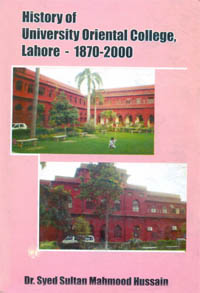Centre of oriental learning
History of University Oriental College, Lahore — 1870-2000
By Dr Syed Sultan Mahmood Hussain.
Izharsons, Lahore. Pages 821. Rs 700.
Reviewed by M. Rajivlochan
THE twists and turns of history often edit out a lot of information from our memories. Remembering the past is always subservient to its uses in the present. Some of this we see in this quaint history of the Oriental College compiled by Syed Sultan Mahmood Hussain. The 19th century was a time when many Indians were trying to help India out of the morass in which the country seemed to have gotten into. One of the more popular beliefs was that the way out was through education, especially modern education, which resulted in a number of movements to promote school and college education. One such was the foundation of the Oriental College to ensure that the knowledge of languages like Sanskrit, Persian and Arabic was not lost. There was also a hope that these languages might become the basis for the spread of modern learning.
 Lahore in the 19th century was the centre of the culture of the Punjab. The efforts of Christian missionaries in conjunction with the active Brahmo Samajis, who had settled in Punjab, resulted in the setting up of the Oriental College in Lahore. One of the popular beliefs, wrongly held, was that the Adi Brahmo Samaj preacher Pundit Navin Chandra Rai was instrumental in founding the college. The role of the Hungarian orientalist G.W. Leitner, in setting up the college and subsequently Panjab University, is all but forgotten. All that remains of that great man at present is a statue that stands by the Mall Road outside the college boundary wall. The present book ensures that the efforts of Leitner in interfacing between Indians seeking to promote oriental learning and the Government of India keen on letting oriental learning fall into the dustbin of history are duly remembered.
Lahore in the 19th century was the centre of the culture of the Punjab. The efforts of Christian missionaries in conjunction with the active Brahmo Samajis, who had settled in Punjab, resulted in the setting up of the Oriental College in Lahore. One of the popular beliefs, wrongly held, was that the Adi Brahmo Samaj preacher Pundit Navin Chandra Rai was instrumental in founding the college. The role of the Hungarian orientalist G.W. Leitner, in setting up the college and subsequently Panjab University, is all but forgotten. All that remains of that great man at present is a statue that stands by the Mall Road outside the college boundary wall. The present book ensures that the efforts of Leitner in interfacing between Indians seeking to promote oriental learning and the Government of India keen on letting oriental learning fall into the dustbin of history are duly remembered.
In its early days, the college was part of Calcutta University. Its first examinations were fixed for March 1866. Initially, it was to be called the "Lahore and Amritsar College" and was to form the nucleus of teaching for a university that would come up in the future around the college. It was proposed by the supporters of the college that the government offer a jagir to the university. The income from this jagir would defray the cost of running it. As it turned out in later years, the university that came up did not get any jagir but its benefactors did continue to offer it large pieces of real estate to run its operations.
In fact, the government was wary of allowing a university to be set up in the Punjab. All that it agreed to was a college. It was thus that instead of the Lahore and Amritsar College, a college called the Oriental College came into existence. The success of this college in imparting education to the people of the Punjab was one of the factors that persuaded the Government of India to allow for the setting up of Panjab University in Lahore seven years later.
Hussain places detailed excerpts from the official records of the college before the reader. This includes, inter alia, the names of students who graduated, the faculty members, the important visitors to the college and much more. It almost seems that he is following the dictum of the 19th-century German historians who insisted that all history has to be based on written documents. This procedure might seem old fashioned, but it does have the advantage of providing the interested reader with much information without intervention from the historian.
As time passed, the Oriental College became home to a number of scholars like Leitner, Arnold, Auriel Stein and later the young Lala Jagan Nath Agarwal, who left their indelible mark on orientalist learning. Once Panjab University came to be found in 1882-3, the college began to specialise only in language, literature and philosophy.
The fortunes of the college, however, seemed to change once it became clear after Independence that there was not much need of orientalist learning any more. The college tried to modernise by including Russian, French, German, Iranian, Turkish and Spanish courses. Pandering to the government, it even offered a course on Kashmiriyat. However, in the absence of sensitivity to the modern way of learning languages, it became sluggish. The number of students did not rise beyond what they were in 1947 and the faculty remained at a low 31 as late as the year 2000.
The Tribune: October 23, 2011